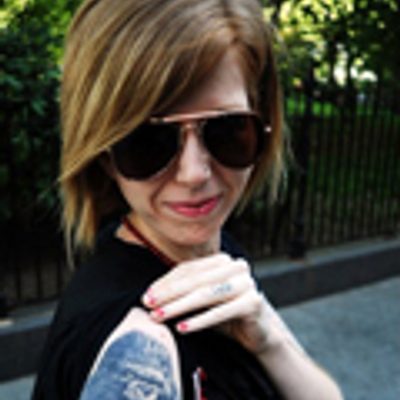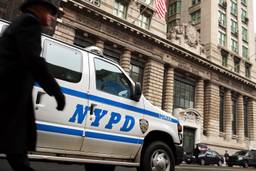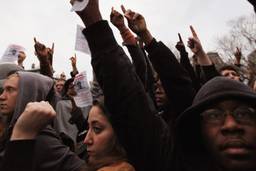On Dec. 17, about 50 people were arrested after they scaled a fence to gain access to a lot owned by Trinity Church following a celebratory gathering marking Occupy’s three-month anniversary across the street at Duarte Square.
For months, protesters had been beseeching the church for use of their land. In other words, to grant OWS sanctuary.
Harvard Divinity School alum Chris Hedges appealed to Trinity earlier in the month to allow the occupiers use of the vacant lot.
The Occupy movement is the force that will revitalize traditional Christianity in the United States or signal its moral, social and political irrelevance. The mainstream church, battered by declining numbers and a failure to defiantly condemn the crimes and cruelty of the corporate state, as well as a refusal to vigorously attack the charlatans of the Christian right, whose misuse of the Gospel to champion unfettered capitalism, bigotry and imperialism is heretical, has become a marginal force in the life.
It was the church in Latin America, especially in Central America and Augusto Pinochet’s Chile, which provided the physical space, moral support and direction for the opposition to dictatorship. It was the church in East Germany that organized the peaceful opposition marches in Leipzig that would bring down the communist regime in that country. It was the church in Czechoslovakia, and its 90-year-old cardinal, that blessed and defended the Velvet Revolution. It was the church, and especially the African-American church, that made possible the civil rights movements. And it is the church, especially Trinity Church in New York City with its open park space at Canal and 6th, which can make manifest its commitment to the Gospel and nonviolent social change by permitting the Occupy movement to use this empty space, just as churches in other cities that hold unused physical space have a moral imperative to turn them over to Occupy movements.
Where is the church now? Where are the clergy? Why do so many church doors remain shut? Why do so many churches refuse to carry out the central mandate of the Christian Gospel and lift up the cross.
Alas, the church seems more preoccupied with its role as real estate powerhouse (Trinity Church is one of the largest landholders in all of Manhattan) than in answering the question: What would Jesus do?
There are some churches, however, that have stepped forth to fill the empathy void left by Trinity. Specifically, Park Slope United Methodist and West Park Presbyterian Church on the Upper West Side have agreed to house 30 and 60 to 100 protesters, respectively.
Herb Miller, the pastor at Park Slope United Methodist, opened his small church to protesters about two weeks after they were ejected from Zuccotti on Nov. 15. About 30 have slept there each night since. “I mapped out with my administrative assistant how many bodies we could fit on the floor,” said the 51-year-old pastor.
He said he has the full support of his congregation and called the effort “radical hospitality.” “You have this sacred space cordoned off, but it’s also made sacred by the people,” Pastor Miller said.
…
West Park’s pastor, Robert Brashear, said the church had a long tradition of supporting activism, having launched a program for gays, bisexuals and transsexuals and founding the charity God’s Love We Deliver.
“Occupy Wall Street is simply carrying on the tradition of what this church has been for decades,” said Mr. Brashear, the church’s pastor for 15 years.
A quick addendum on other Occupy-related matters, both concerning police behavior during the mass arrests that occurred at Occupy Wall Street and Occupy Oakland.
In Oakland, Officer John Hargraves is facing a one-month suspension after being videotaped at a recent Occupy Oakland protest with the name on his uniform covered by black tape. Hargraves’ superior officer, Lt. Clifford Wong, was demoted to sergeant for failing to report the incident to internal affairs.
Hargraves remains on the job while he appeals the suspension.
State law requires on-duty, uniformed police officers to display their names or identification numbers.
In court papers, Hargraves wrote that he had covered his name moments before the video operator came up to him. Hargraves said a watch commander had reported a day or two earlier that the name, home address and identities of family members of an officer from another agency had been posted on the Internet after Occupy protesters videotaped the officer.”
The video involving that other officer also called for violence against the officer, including burning down his home,” Hargraves wrote. “This caused me great concern for the safety of my family.”
But civil rights attorney Jim Chanin said Wednesday, “That’s like saying that you can steal from a store because you’re poor. If you take that to its logical conclusion, every police officer every day faces possible exposure and danger because their names are on their badges.”
Here is the video showing Hargraves with his name blacked out and Wong walking over to speak with the officer.
On the east coast, several hundred protesters are awaiting their chance at a public trial following the Sept. 24 Union Square and Oct. 1 Brooklyn Bridge mass arrests. It seems likely that many of the cases will be consolidated into single trials, according to Martin Stolar of the National Lawyers Guild.
For a group of protesters intent on spreading their anti-corporate message – and drawing attention to what they say were illegitimate arrests – the prospect of larger, multi-defendant trials is a double-edged sword.
On one hand, NLG lawyers said Wednesday, pursuing hundreds of individual trials could result in dismissals if police officers and other witnesses are unavailable to testify in multiple trials.
On the other hand, Stolar said, consolidated trials would probably last for days and garner additional media attention, which would appeal to protesters. Individual trials, by contrast, would last perhaps half a day each, given that the vast majority of protesters are charged with misdemeanors such as disorderly conduct or blocking vehicular traffic.
Eight protesters have accepted adjournments in contemplation of dismissal (ACD,) which means the charges will be dismissed as long as the defendant is not arrested within the next six months.
Erin Duggan, a spokeswoman for the Manhattan district attorney’s office told Reuters that about half of the 1,8000 Occupy-related cases that have been handled by her office have been resolved, the majority through ACDs.
The obvious problem with ACDs is that if a protester is arrested on a trumped up charge to begin with (say, “disorderly conduct” for the crime of speaking publicly as we saw during the recent Grand Central arrests,) then that protester is effectively barred from pursuing a similar protest style for the next six months.
Accepting ACDs sometimes scares off activists from the protest scene, or at the very least, severely handicaps how effectively civil disobedience is implemented by activists, who are suddenly more preoccupied with the fear of getting arrested again than they are in expressing themselves.
Meanwhile, six other cases were dismissed because prosecutors said they did not believe the charges could be proven beyond a reasonable doubt.




